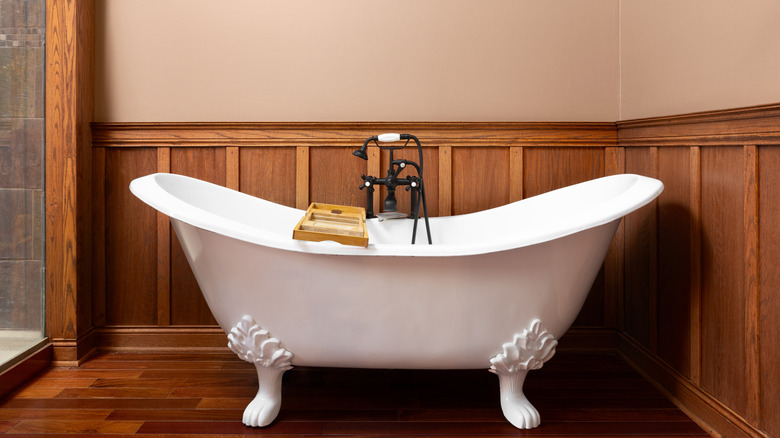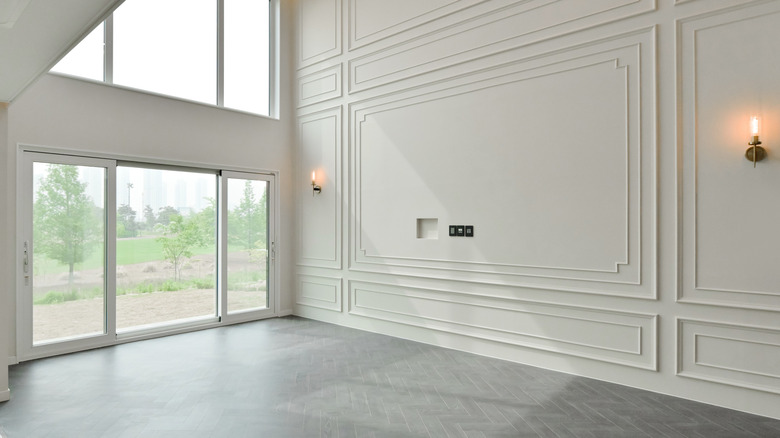How To Calculate The Ideal Height For Wainscoting On An Accent Wall
Wainscoting is a popular type of decorative wall paneling that had very practical beginnings. It dates back to the 16th century U.K., before moisture barriers were used in walls. Dampness rising from the ground would cause unsightly marks, blistered paint, or mold on walls, and wainscoting was used to hide it.
Originally, wainscoting only hid the lower third of the wall, but nowadays, it's not unusual to find half, or even whole walls being covered. So, the big question for many is how to calculate the ideal height for wainscoting. I'm House Digest's carpentry and remodeling expert, and I'm going to help you find the answer.
When deciding on the wainscoting height, try the classic 36 inches as a start. It can be difficult to visualize the height for your wainscoting when you're looking at a blank wall, but the simplest way to do this is to mark a horizontal line with chalk (because it's easy to wipe off). If you have furniture for the room, try putting some of it near the line. Move the mark up or down until you're happy. You could also take a sheet of cardboard or even plywood and cut it to the proposed height to give some visual depth. Below, I'm going to explain how style and material choices affect the height and the cost to install wainscoting. I'll also discuss reducing waste during installation to save you money.
How style and materials could impact the ideal height for your wainscoting
Hopefully, the chalk mark trick will get you somewhere near your ideal height for wainscoting, but there are other elements to consider before making a final decision. For example, there is more than one wainscoting style. Raised panels or board and batten create squares or rectangles reminiscent of libraries and Victorian studies. Beadboard or tongue-and-groove gives a vertical effect often found in hallways and bathrooms. Also, consider what materials you'll get the wainscoting in. Although these panels were originally made of wood, today MDF, PVC, and composite alternatives are often cheaper. There's even wallpaper that gives the look of wainscoting on a budget.
So how do these factors affect height? If you're having wainscoting custom made, a carpenter can build and fit it to whatever height you want. On the other hand, if you're saving money by going with store-bought MDF or PVC panels, they come at a fixed height and can be difficult, or even impossible, to modify. However, you do still have a choice over baseboard depth and top rail thickness (often called wainscot cap). So, while flexibility is limited, by varying these, you should be able to get close to your ideal height.
How to DIY wainscoting at the ideal height with minimal waste
The video shows wainscoting that uses 8-inch baseboards, 4-foot center panels, and a 4-inch top rail. The finished wainscoting is 5 feet tall. Tongue-and-groove boards are typically available in 8- or 12-foot lengths, so having the middle pieces 4-feet tall means you get either two or three out of each board, and no waste.
Whether or you like the aesthetics of the wainscoting in the video or not, it's the way the creator got to the desired height that matters. You can use this principle to calculate the ideal height for your wainscoting with some simple math. Let's say you want 38-inch wainscotting. You might choose a 4-inch baseboard and a 2-inch top rail (or trim molding). That leaves 32 inches for each center board. So, you'll get three of them from an 8-foot sheet, and four and a half from a 12-foot sheet — the waste is minimal. If you wanted a finished height of 36 inches, you could follow the same calculations and end up with a negligible amount of waste.
Using this example, you could make the wainscoting up to 42 inches tall at no extra cost. You could increase that further with a deeper baseboard or top rail. Each is readily available in a variety of sizes. This method allows you to calculate the ideal height for wainscoting either purely based on what pleases you visually or taking into account what is most economical.

